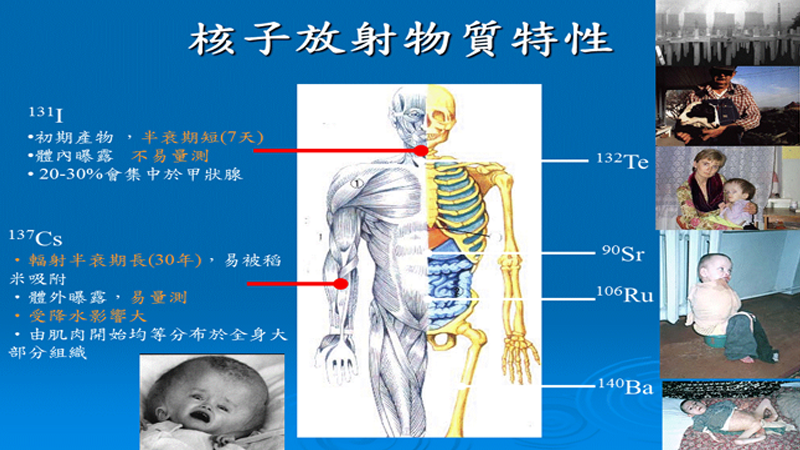針對本次日本宮城核電廠可能發生的核子事件,基本上與二十多年前的車諾比事件不同,預估排放出來 的核子輻射量也有天壤之別,天氣風險公司氣象團隊除了以氣流軌跡擴散方式研判不會影響台灣外,並以1986年車諾比事件當時的 CS 137 排放濃度為模擬方式,進行若未來幾天有輻射擴散時的傳送方式,發現要到永久封鎖的場所就是在核電廠旁約三十公里,其餘藍顏色就是要避難減少被暴露機會就可,未來幾天排放方式都很類似。是不是會影響到美國? 其實會,但量不多,不致於對人體有直接傷害。對台灣完全沒有任何影響。

核子擴散的傳播方式和海嘯不同,海嘯傳遞速度快,但核子擴散是透過大氣的傳送,速度較慢,例如本團隊過去針對日本核電廠的擴散評估,以全年來看影響的機率約 10%,以秋季影響機會最大,春季佔 14%,本次而言,未來七天的風場評估,不會對台灣有直接影響。
日本強震引發的核災危機,這是新興的複合式災難,遠超乎國人想像,未來對於天災預警,後續也非常值得我們關注,也請各位民眾要提高警覺。
台灣鄰近國家也有相當多的核電廠,未來這種複合式災難對台灣影響實值得大家重視。
本研究團隊成員於十年前於國立中央大學 服務期間即進行相關研究,近年來研究成果也發表在相關論文,可詳見
境外核子事故擴散對台灣影響之探討
彭啟明(Chi-Ming Peng);劉啟文(Chi-Wun Liou);張闊顯(Kuoh-Shean Chang);林能暉(Neng-Hui Lin)
本研究旨在模擬輻射塵在大氣中的傳送行為與分布情形及對台灣之影響評估,針對東亞核電廠進行氣流軌跡模擬,結果顯示中國廣東大亞灣核電廠與上海秦山核電廠氣流較易影響台灣,到達台灣機率為7-12%,到達台灣時間為46小時左右;韓國與日本南部之核電廠,氣流到達台灣之機率為10%,平均到達台灣之時間約為72小時。由季節頻率分布結果顯示中國南方核電廠與中國北方、韓國、日本等核電廠氣流影響台灣分別集中在春夏季與秋冬季,亞洲季風是主宰大氣擴散之主因。嚴重核事故情境之全年模擬顯示,中國核電廠輻射塵影響台灣機率為50-70%之間,台灣北部地區平均輻射沉降量約為103 Bq m^(-2)以上,其輻射塵經過20-30小時即可到達台灣。當梅雨鋒面經過台灣時,若中國大亞灣核電廠發生嚴重核事故,則台灣北部地區大約在第48小時左右將承受10^4-10^5 Bq m^(-2)之Cs-137 輻射塵沉降量;秦山核電廠輻射塵沉降至台灣的天氣型態為大陸冷高壓位於黃河河套,且事故當時無降水之際,估計最快到達台灣時間為一日之內,沉降區域涵蓋台灣60%之陸地。
This study is aimed to simulating the transport and dispersion of radioactive dust using an atmospheric transport model, and further to assess its impact on Taiwan. Based on 2001 ECMWF meteorological data, we characterized the forward trajectories of airflows originating from 10 nuclear power plant stations in East Asia, and also calculated the frequency of contaminated airflows arriving in Taiwan. The results showed that the airflow from the Qinshan power plant station in China has the highest frequency of 12% reaching Taiwan, and the average travel time is about 2 days. For the airflow from Korea and Japan, the frequency is about 10%, and travel time is within three days. The airflow arriving in Taiwan is strongly associated with Asian Monsoon. A yearly simulation for the serious nuclear accident in Qinshan and Guangdong power plants was conducted. The results showed that Taiwan is located within a of 50-70%, the average Cs-137 deposition in northern Taiwan is about 103 Bq m^(-2) and travel time is within 20-30 hours. For the case of a frontal passage over northern Taiwan, 10^4-10^5 Bq m^(-2) was obtained within 25 hours. In contrast, when Qinshan nuclear power plant occurred severe accident in the case of northeast monsoon, radioactive dust can reach Taiwan within 1 day and cover the 60% of Taiwan land.
論文網址為:
http://www.airitilibrary.com/searchdetail.aspx?DocIDs=22201424-201011-201012080074-201012080074-15-28